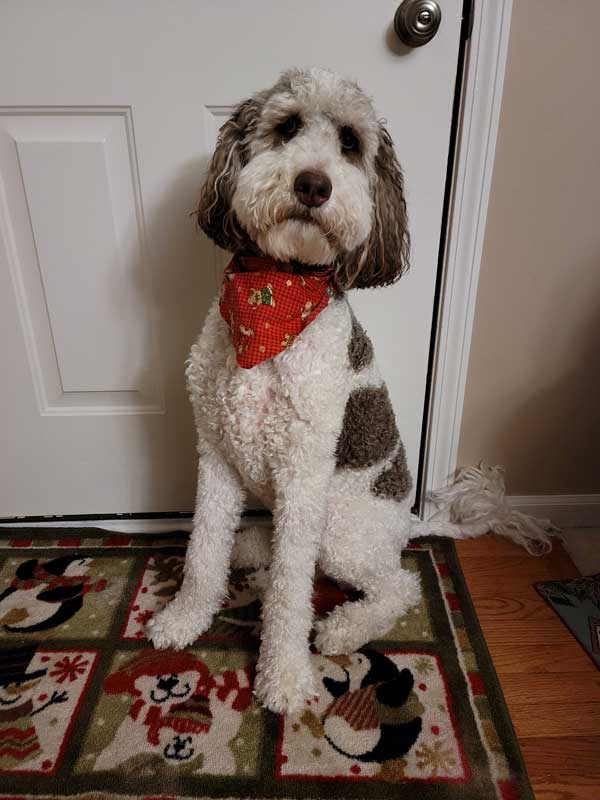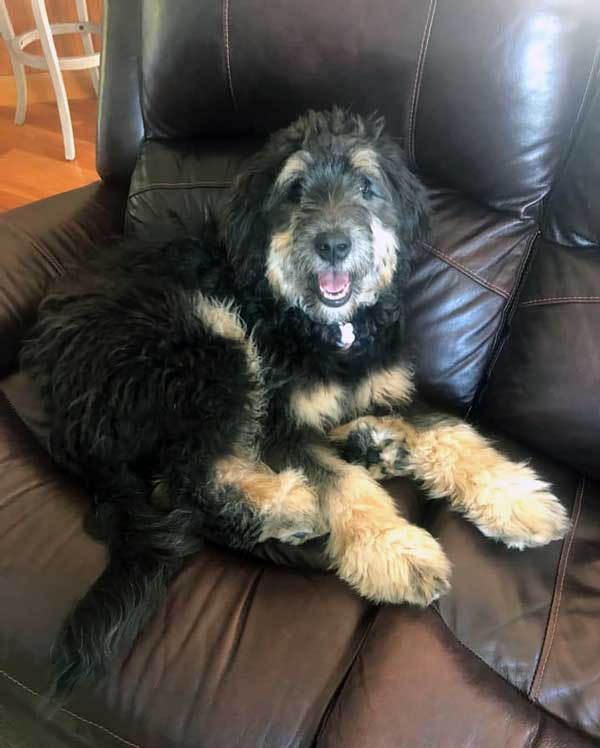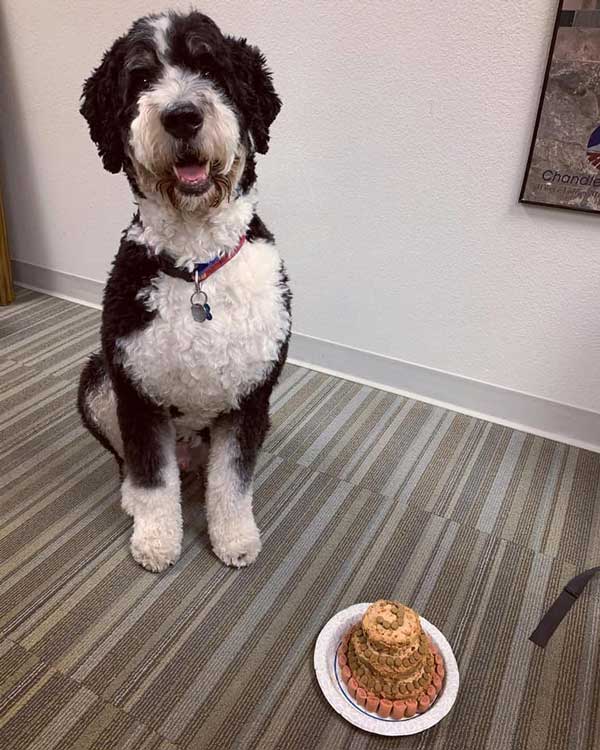Meet Our Bernadoodles
This popular canine is a hybrid of the Bernese Mountain Dog and a Poodle. Either parent dog can be one of these two breeds, it doesn’t change the look if the Mom is the Poodle and the Dad is the Bernese Mountain Dog or if Mom is a Bernese Mountain Dog and the dad is the Poodle. As long as both breeds are in the mix, we folks, have ourselves a Bernedoodle!
Bernadoodle Generations We Raise Here at Apple Creek
F1 Bernedoodle – One Parent is a Bernese Mountain Dog and one is a Poodle, this generation results in a puppy that is 50% Bernese Mountain Dog and 50% Poodle.
Our F1 Bernedoodles originate from a Bernese Mountain Dog Dad and a Poodle Mom. This blend has a large amount of genetic diversity, so the F1 Bernedoodle appearance can widely vary. For instance, the coat could appear straighter, like a Bernese Mountain Dog, it could have the curliness of the Poodles coat, or it could be somewhere in between. While most F1 Bernedoodles will likely shed less than a Bernese Mountain Dog, they still have a decent probability of shedding a little and triggering allergy-sufferers. So, if you have dog allergies, you may have better luck with an F1b Bernedoodle which has more poodle and less Bernese in the mix.
F1b Bernedoodle – One Parent is an F1 Bernedoodle and one is a Poodle, this generation results in a puppy that is 25% Bernese Mountain Dog and 75% Poodle.
F1b Bernedoodles will shed less than F1 Bernedoodles and are suitable for most families with allergies. With the F1B Bernedoodle, you lose some of the genetic diversity, by reintroducing the Poodle. However the advantage is a more predictable coat. The more Poodle DNA a puppy has, the more likely they are to be lower shedding and more hypoallergenic, as compared to an F1 Bernedoodle. So this generation is a safer bet for families dealing with mild allergies.
F1bb Bernedoodle – One Parent is an F1b Bernedoodle and one is a Poodle, this generation results in a puppy that is 12.5% Bernese Mountain Dog and 87.5% Poodle.
The F1BB Bernedoodle generation is designed with allergy sufferers in mind. Because this generation is closer to the Poodle than the Bernese Mountain Dog, it has a much better chance of being non-shedding and hypoallergenic, although it is important to remember that there are no guarantees. But if allergies are a concern, an F1BB Bernedoodle is the best generation for you to seek out. There will be less genetic diversity than in other generations. Both appearance and temperament are more likely to be Poodle-like. While this means you are more likely to get a hypoallergenic coat, this also means this coat will likely be curly and high-maintenance when it comes to grooming.
Living with a Bernadoodle
An eager-to-please and intelligent dog like the Bernedoodle is a joy to train. But don’t take their gentle demeanor as an invitation to forgo training altogether. They are playful and can be a bit domineering, so it’s important to teach them the rules of the household early on. One other thing to keep in mind when it comes to Bernedoodles is that it’s hard to know whether their personality will be mostly Bernese Mountain Dog or mostly Poodle. In the former case, you’ll have a dog that is easy-going and sometimes shy or timid around strangers. If the Poodle genes take over, you’ll have a doggo that is confident and intelligent with a bit of a stubborn streak.
There’s another advantage to training, too – it stimulates the Bernedoodle’s intelligence. Without these mental challenges, you might see a dog with frustration and pent-up energy.
The best way to approach training with a Bernedoodle is to make it fun and get everyone in the family involved. Obviously, you don’t want seven family members shouting at once, but instead, make sure that every member has some training time with the pup. That way, your Bernedoodle will know their place in the household and have a chance to bond with each member of the family.
And remember to balance sternness with praise when training a Bernedoodle. Like their Bernese Mountain Dog parent, these pups have a sensitive side.
Health and Life Expectancy
Bernedoodles tend to be healthier dogs than either of their parents. Inbreeding has left many purebred dogs open to genetically inherited diseases and conditions, but cross-breeding reduces that risk. Because this breed hasn’t been around for very long, information about health concerns for Bernedoodles is somewhat limited. The instances of cancer in the Bernedoodle seem to be lower than those of the Bernese Mountain Dog.
There are, however, some conditions that Bernedoodles may be predisposed to, including hip dysplasia, elbow dysplasia, eye problems, and skin issues such as allergies and hot spots. All breeds may be affected by any number of health concerns, but the Bernedoodle is generally a healthy breed.
Regardless of how healthy your dog is when you first bring them home, you should prepare for any issues that may come up throughout their life. A pet insurance plan can help you stay ready for any of your dog’s veterinary needs.
I’d say the life expectancy for most dogs these days is 10-12 years. Smaller breeds will live a bit longer than large breeds. A lot depends on keeping them at a healthy weight, not pumping tons of chemicals into them by way of flea/tick treatments or over vaccinating, keeping them away from yard pesticides and all of the bad treats out there that are not beneficial for them.




